Major Arcana Tableaux
The tableau most frequently written about of all is the Qabalistic Tree of Life. Most authors follow the Golden Dawn in arranging cards on this glyph, but there are other arrangements that have been written about. For instance, that behind the R.J. Stewart Merlin and Dreampower decks, and that behind Julia Turk's Navigators of the Mystic Sea deck.
But this page is about tableaux that don't necessarily have anything to do with Qabala. These other tableaux are less frequently discussed. Here is a collection of them... should you run across one I don't have, please email me so I can add it!
Threes (Triad, Triptych, Ternary)
| Tableaux I |
| 0 | 1 | 2 |
| 3 | 4 | 5 |
| 6 | 7 | 8 |
| 9 | 10 | 11 |
| 12 | 13 | 14 |
| 15 | 16 | 17 |
| 18 | 19 | 20 |
| 21 |
|
| Tableaux II |
| 0 |
| 1 | 2 | 3 |
| 4 | 5 | 6 |
| 7 | 8 | 9 |
| 10 | 11 | 12 |
| 13 | 14 | 15 |
| 16 | 17 | 18 |
| 19 | 20 | 21 |
|
In general, the TdM fits this structure very well.
Tableau I - Michael J. Hurst especially his Exoteric Layers of TdM and Tom Tadfor Little in The Triadic Structure of the Tarot
In this tableau, the first column is essentially female, the second male, and the third contains religious guides and moral virtues. Or as Hurst puts it, 1st Col - Active, 2nd Col - Passive, 3rd Col - Mediating
Tableau II - p. 37 Oswald Wirth in The Tarot of the Magicians (originally published 1927 Le Tarot, des Imagiers du Moyen Age)
The Seven Ternaries - 1st Col - Active - Spirit, 2nd Col - Intermediary - Soul, 3rd Col - Passive - Body
p. 27 Mary K. Greer - Tarot For Your Self (TFYS) "John D. Blakeley in The Mystical Tower of the Tarot describes his search for the possible Sufi origin of the Tarot. He found a book written in 1899 called The Mystic Rose from the Garden of the King by Sir Fairfax L. Cartwright. ... a wanderer approaches a tower ... There are three chambers on each floor, each containing a living Tarot archetype..."
Fours (Quatrad)
| Tableaux III |
| 0 | 1 | 2 | 3 |
| 4 | 5 | 6 | 7 |
| 8 | 9 | 10 | 11 |
| 12 | 13 | 14 | 15 |
| 16 | 17 | 18 | 19 |
| 20 | 21 |
|
| Tableaux IV |
| 0 |
| 1 | 2 | 3 | 4 |
| 5 | 6 | 7 | 8 |
| 9 | 10 | 11 | 12 |
| 13 | 14 | 15 | 16 |
| 17 | 18 | 19 | 20 |
| 21 |
|
I have not found Tableau III discussed anywhere yet
Tableau IV - Tarot Revelations
Sevens (Septenary)
| Tableaux X |
| 0 | 1 | 2 | 3 | 4 | 5 | 6 |
| 7 | 8 | 9 | 10 | 11 | 12 | 13 |
| 14 | 15 | 16 | 17 | 18 | 19 | 20 |
| 21 |
|
| Tableaux XI |
| 1 | 2 | 3 | 4 | 5 | 6 | 7 |
| 8 | 9 | 10 | 11 | 12 | 13 | 14 |
| 15 | 16 | 17 | 18 | 19 | 20 | 21 |
| 0 |
|
I have not found Tableau X discussed anywhere yet
Tableau XI - Case, Pollack "Triseptem Matrix", p. 1 TFYS (1st 7=body, 2nd 7=mind, 3rd 7=spirit)
Wirth p. 37 "The Three Septenaries" (1st row=active-spirit, 2nd row=intermediary-soul, 3rd row=passive-body)
Other meanings of levels:
1st: powers and potencies, consciousness, world around us
2nd: laws or agencies, subconscious, exploring inwards
3rd: conditions or effects, superconscious, great adventure
Nines (Ennead, "Magic Nine")
| Tableaux V |
| 0 | 1 | 2 | 3 | 4 | 5 | 6 | 7 | 8 |
| 9 | 10 | 11 | 12 | 13 | 14 | 15 | 16 | 17 |
| 18 | 19 | 20 | 21 |
|
| Tableaux VI |
| 1 | 2 | 3 | 4 | 5 | 6 | 7 | 8 | 9 |
| 10 | 11 | 12 | 13 | 14 | 15 | 16 | 17 | 18 |
| 19 | 20 | 21 | 0 |
|
| Triple Ternaries |
|
|
|
I have not found Tableau V discussed anywhere yet
Tableau VI - This is the tableau most written about
pythagorean reduction equalities
Richard Roberts
p. 8 TFYS - difference between higher and lower is nine, below card theosophic adds to number above
Hajo Banzhof
Gilbert
Triple Ternaries discussed p. 39-41 Wirth. Pairing each position results in Tableau VI.
Tens (Decad)
| Tableaux VII |
| 0 | 1 | 2 | 3 | 4 | 5 | 6 | 7 | 8 | 9 |
| 10 | 11 | 12 | 13 | 14 | 15 | 16 | 17 | 18 | 19 |
| 20 | 21 |
|
| Tableaux VIII |
| 0 | | 1 | 2 | 3 | 4 | 5 | 6 | 7 | 8 | 9 | 10 |
| 21 | | 11 | 12 | 13 | 14 | 15 | 16 | 17 | 18 | 19 | 20 |
|
I have not found Tableau VII discussed anywhere yet
Tableau VIII - Nigel Jackson - p. 19 "The tetractys: this number scale corresponds to the cards 1-X of the Greater Arcana. Cards XI-XX represent the "doubling" of the Dekad, the cosmic cycles of outgoing evolution and ingoing return symbolized by the ancient Cosmic Lemniscate sign of Infinity"
Elevens (Hendecad)
| Tableaux IX |
| 0 | 1 | 2 | 3 | 4 | 5 | 6 | 7 | 8 | 9 | 10 |
| 11 | 12 | 13 | 14 | 15 | 16 | 17 | 18 | 19 | 20 | 21 |
|
| Tableaux XII |
| 1 | 2 | 3 | 4 | 5 | 6 | 7 | 8 | 9 | 10 | 11 |
| 0 | 21 | 20 | 19 | 18 | 17 | 16 | 15 | 14 | 13 | 12 |
|
| |
| Tableaux XIII |
| | 21 | |
| 0 | | 20 |
| 1 | | 19 |
| 2 | | 18 |
| 3 | | 17 |
| 4 | | 16 |
| 5 | | 15 |
| 6 | | 14 |
| 7 | | 13 |
| 8 | | 12 |
| 9 | | 11 |
| | 10 | |
|
I have not found Tableau IX discussed anywhere yet, yet I had these notes next to it:
first half - external forces or outlook; second half (justice=11) internal development or wisdom
Tableau XII - Wirth pp. 26-32. Starts with placing the cards in the shape of a wheel, which is then divided into two halves of 11 each. These are discussed as a contrast between Dorian and Ionian. He also shows how each row is divided into to 2 equal parts by cards 6 and 17. The left-hand group being Theory and the right-hand group Practice. He discusses the four groups, then the eleven couples, and then comes up with comparative tetrads ... I need to create graphics to show this, but these are the tetrads: 1-11-0-12, 2-10-21-13, 3-9-20-14, 4-8-19-15, 5-7-18-16, 2-5-21-18, 3-4-20-19, 7-10-16-13, 8-9-15-14.
I think this is the one that corresponds to the Temple of Serapis story triggered by Bernard Bromage The Occult Arts of Ancient Egypt ("The Tarot, of course, originated from the Temple of Serapis in Naples, Italy.") and continued by Michael Poe describing an excavation report.
Paul Christian (Jean Baptiste Pitois) These Tarot cards descriptions are found in The Mysteries of the Pyramids, being the Book II in The History and Practice of Magic, by Paul Christian (1811-77). Papus was another writer who connected the trump images with Ancient Egypt.
Tableau XIII - This is the Figure 8 of RWS, each column sums to 21, involution - evolution cycle
Alfred Douglas
Barbara Walker
p. 158 TFYS - Paul Christian
Peter Balin
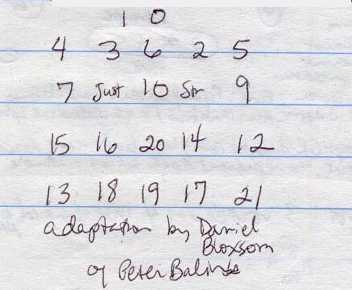
Manly P. Hall, Modified by Daniel Bloxsom according to Gareth Knight
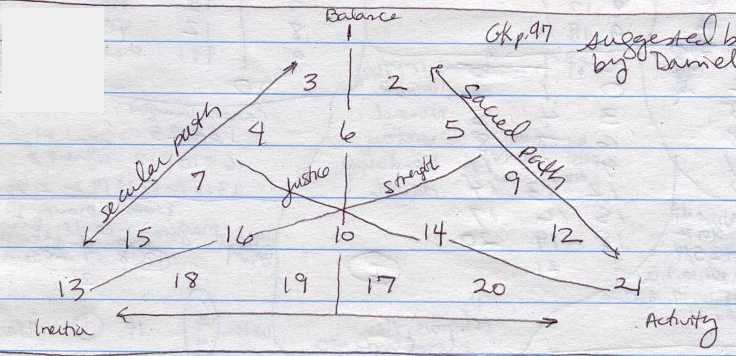
Genetti's Tree
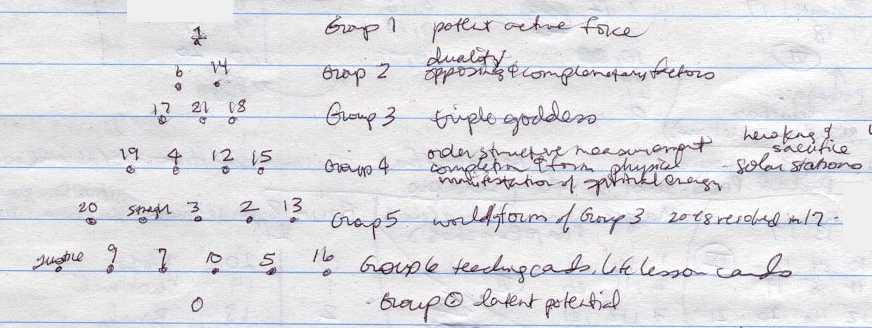
Ouspensky

Motherpeace Dancing Wheels
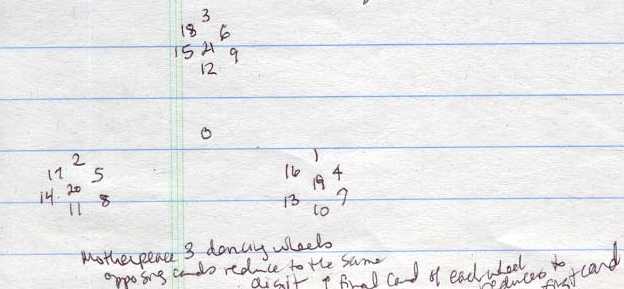
Knight Vortices

Knight Center Magus
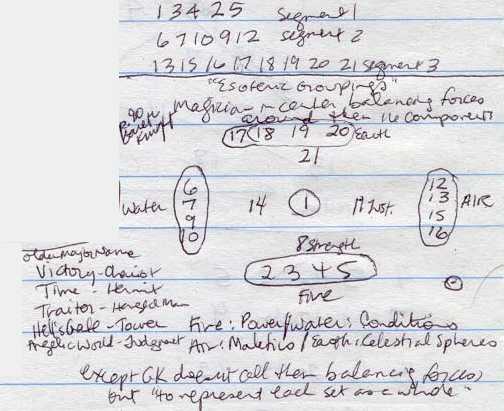
Pages from Pythagorean Tarot
Hexactys' from Introduction to Major Arcana
Tony Smith
This page is a view of the Tarot from the point of view of
underlying mathematical structures, to see whether it
might represent well-defined mathematical objects
that can be used to build models such as
the D4-D5-E6 physics model that describe physical phenomena
in ways that are consistent with experimental observations.
Return to Main Page of Study Helps






